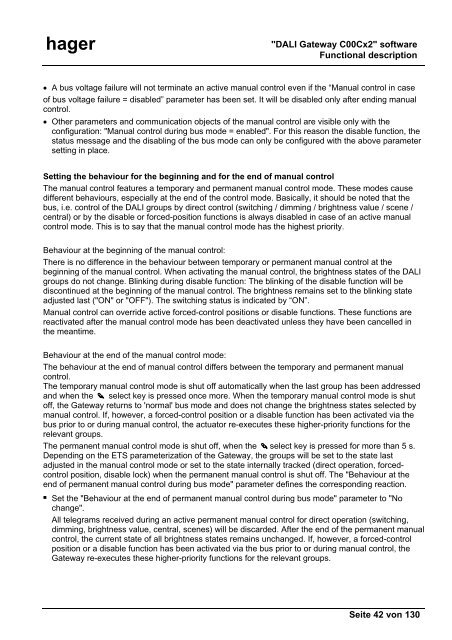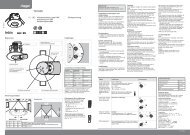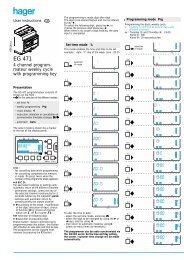hager TX216 KNX/EIB DALI-Gateway - UTU
hager TX216 KNX/EIB DALI-Gateway - UTU
hager TX216 KNX/EIB DALI-Gateway - UTU
- No tags were found...
You also want an ePaper? Increase the reach of your titles
YUMPU automatically turns print PDFs into web optimized ePapers that Google loves.
<strong>hager</strong>"<strong>DALI</strong> <strong>Gateway</strong> C00Cx2" softwareFunctional description• A bus voltage failure will not terminate an active manual control even if the “Manual control in caseof bus voltage failure = disabled” parameter has been set. It will be disabled only after ending manualcontrol.• Other parameters and communication objects of the manual control are visible only with theconfiguration: "Manual control during bus mode = enabled". For this reason the disable function, thestatus message and the disabling of the bus mode can only be configured with the above parametersetting in place.Setting the behaviour for the beginning and for the end of manual controlThe manual control features a temporary and permanent manual control mode. These modes causedifferent behaviours, especially at the end of the control mode. Basically, it should be noted that thebus, i.e. control of the <strong>DALI</strong> groups by direct control (switching / dimming / brightness value / scene /central) or by the disable or forced-position functions is always disabled in case of an active manualcontrol mode. This is to say that the manual control mode has the highest priority.Behaviour at the beginning of the manual control:There is no difference in the behaviour between temporary or permanent manual control at thebeginning of the manual control. When activating the manual control, the brightness states of the <strong>DALI</strong>groups do not change. Blinking during disable function: The blinking of the disable function will bediscontinued at the beginning of the manual control. The brightness remains set to the blinking stateadjusted last ("ON" or "OFF"). The switching status is indicated by “ON”.Manual control can override active forced-control positions or disable functions. These functions arereactivated after the manual control mode has been deactivated unless they have been cancelled inthe meantime.Behaviour at the end of the manual control mode:The behaviour at the end of manual control differs between the temporary and permanent manualcontrol.The temporary manual control mode is shut off automatically when the last group has been addressedand when the select key is pressed once more. When the temporary manual control mode is shutoff, the <strong>Gateway</strong> returns to 'normal' bus mode and does not change the brightness states selected bymanual control. If, however, a forced-control position or a disable function has been activated via thebus prior to or during manual control, the actuator re-executes these higher-priority functions for therelevant groups.The permanent manual control mode is shut off, when the select key is pressed for more than 5 s.Depending on the ETS parameterization of the <strong>Gateway</strong>, the groups will be set to the state lastadjusted in the manual control mode or set to the state internally tracked (direct operation, forcedcontrolposition, disable lock) when the permanent manual control is shut off. The "Behaviour at theend of permanent manual control during bus mode" parameter defines the corresponding reaction.• Set the "Behaviour at the end of permanent manual control during bus mode" parameter to "Nochange".All telegrams received during an active permanent manual control for direct operation (switching,dimming, brightness value, central, scenes) will be discarded. After the end of the permanent manualcontrol, the current state of all brightness states remains unchanged. If, however, a forced-controlposition or a disable function has been activated via the bus prior to or during manual control, the<strong>Gateway</strong> re-executes these higher-priority functions for the relevant groups.Seite 42 von 130
















